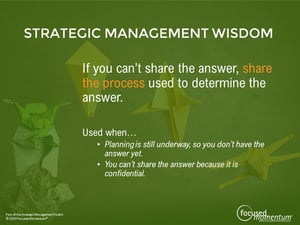How to Drive Strategic Performance (without a strategic plan)
I love the Fall. The seasons are change and we start thinking about the holidays. Right, well maybe for most of us, but for those managing a business...

Leading a project, team, or company can feel all-consuming. There is so much time and attention taken by planning and managing that the equally important role of communicating is given short shrift. The pressure on time and attention is unusually high during the first phase of the strategy implementation when demand increases to manage the existing business while completing detailed planning to achieve future goals. However, this is precisely the right time to step back, gather everyone together, and talk about the new direction again and its early progress.
Too many folks working diligently on demands of the business lose touch with the strategic plan as the last they heard of it was the formal introduction presentation months back. Many may think, “It was exciting to hear about the plans for the future, but there has been no real impact from it. Maybe it was just a management fad.”
This attitude may seem natural, and possibly even desired when management teams have so little specifics to share. We find many leaders choose to keep most of the organization focused on meeting current business goals, rather than wondering how the new direction may impact their job. However, the lack of communication on the progress of the plan can lead to cynicism and resistance to change later when implementation plans are ready and you need everyone on-board and prepared to embrace new actions.
Waning attention is exactly why guiding strategy implementation requires a mid-year check-in on the plan and its progress. It is important to keep the light on the strategic goals early and often to stoke the embers of the excitement unleashed by the introduction and to prepare everyone for the eventual change that will be required.
The objectives for a mid-year strategy implementation review are to:
This mid-year communication should be less formal than the full strategic plan story presentation prepared for its introduction. This update should be quick and easy to get ready, given that time is in short supply at this stage of implementation planning. The agenda should contain three specific topics.
1. Clarify low hanging fruit already plucked.
Although strategic planning is future-focused, there are always insights on current day operations or management practices that, once identified, should be quickly resolved. We call these “low-hanging fruit,” and we encourage action on these changes as soon as agreed upon. Pointing out these changes and connecting them to the planning process is a way to get credit for early wins and demonstrate commitment change.
2. Make the implementation planning visible. 
The update forum is the time to clarify the first wave of strategic objectives and identify the folks that are engaged in these detailed planning efforts. If possible, have each of the implementation teams provide an overview of the process that they are using to complete their work and clarify when their work may impact current operations.
3. Share indications that your strategic thinking is sound.
It never fails that once a new strategic direction crystallizes, those that formulated it see the world from a different perspective. The unique lenses of new strategic thinking look at the environment and its dynamics with a fresh set of factors. Examination of data, market intelligence, and competitive shifts now reveal insights that substantiate planning assumptions and validate strategic goals. Collect these insights and share them at this early stage of implementation to increase confidence in the plan and to stimulate commitment to it.
Guiding strategy implementation in the first few months after announcing a new direction is essential to the success of any strategic plan. Adopting all Four Disciplines for Guide Strategy Implementation in this series to build strong strategic management capabilities in your organization.

I love the Fall. The seasons are change and we start thinking about the holidays. Right, well maybe for most of us, but for those managing a business...

When developing and implementing strategy you are in the business of change, fighting against the inertia of the status quo. Even the most brilliant...

In the last blog post, I discussed how necessary it is to set strategic context repeatedly during the early stages of implementing a new strategic...